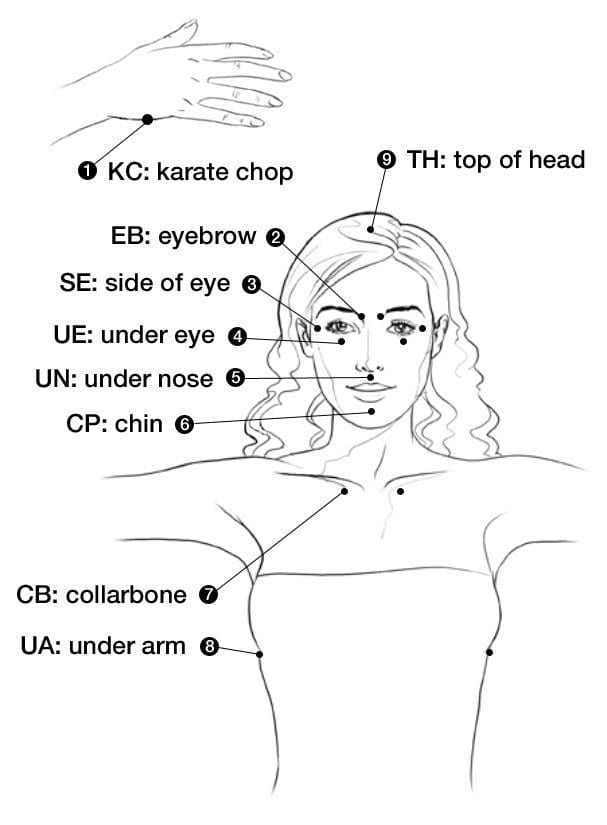Full Disclosure: Clicking on these links could mean a tiny commission for me, at no extra cost to you.
In recent years, the practice of tapping, or Emotional Freedom Techniques (EFT), has gained widespread attention as an effective tool for managing anxiety. Tapping combines elements of traditional Chinese acupressure, modern psychology, and somatic stimulation to address emotional and physical discomfort. This article delves into the fundamentals of tapping for anxiety, the benefits it has to offer for your mental health and a step-by-step guide to incorporating this technique into your life.
What is Tapping (EFT)?
Tapping, often referred to as EFT, is a therapeutic technique that involves tapping on specific meridian points on the body while focusing on a particular issue or emotion. The practice is rooted in the principles of Chinese medicine and was developed in the 1990s by Gary Craig, who believed that imbalances in the body’s energy system could lead to emotional and physical distress.
The Science Behind Tapping for Anxiety
The efficacy of tapping for anxiety relief is supported by a growing body of research. Studies suggest that tapping can help reduce stress hormones, such as cortisol, and improve conditions like anxiety, depression, and PTSD. The process of tapping and focusing on releasing negative emotions helps rewire the brain’s response to stress, promoting a sense of calm and relaxation.
The Meridian Points Used in Tapping

Tapping focuses on nine specific meridian points, each associated with different physical and emotional aspects. These points include:
- The Karate Chop (KC): The side of the hand.
- The Top of the Head (TH): The crown area.
- The Eyebrow (EB): The beginning of the eyebrow.
- The Side of the Eye (SE): The bone bordering the outside corner of the eye.
- Under the Eye (UE): The bone under an eye.
- Under the Nose (UN): The area between the nose and the upper lip.
- The Chin (CH): The area just below the bottom lip and above the chin.
- The Collarbone (CB): The junction where the sternum, collarbone, and the first rib meet.
- Under the Arm (UA): About a hand’s width from the armpit.
How Tapping Can Help with Anxiety
Tapping helps alleviate anxiety by focusing on its physical and emotional symptoms, encouraging a deeper exploration of underlying issues, and fostering acceptance and resolution. It works on the premise that acknowledging and accepting one’s experience can lead to emotional freedom.
But that’s not all.
The Benefits of Tapping
Tapping, or Emotional Freedom Techniques (EFT), offers an abundance of benefits that go far beyond immediate anxiety relief. Here’s a closer look at some of the top advantages:
- Stress Reduction: Regular tapping helps lower stress hormone levels, notably cortisol, promoting a state of relaxation and calm.
- Better Sleep Quality: By reducing stress and anxiety, tapping can lead to better sleep patterns and help combat insomnia.
- Better Emotional Health: Tapping provides a tool for managing anxiety, depression, PTSD and other emotional disorders.
- Physical Health Benefits: Tapping has been reported to offer relief from chronic pain, headaches, and even to improve immune function.
- Self-Empowerment: Learning and practicing tapping gives people a sense of control over their emotional state, fostering greater self-confidence and empowerment.
A Step-by-Step Guide to Tapping for Anxiety Relief
For those looking to deepen their understanding of tapping and explore a wealth of resources, The Tapping Solution offers an excellent platform. This comprehensive tool provides guided tapping sessions, educational content, and community support to help you harness the full potential of tapping for anxiety relief and beyond. It’ll guide you through the following steps so you can easily tap your way towards your goals.
Step 1: Identify Your Anxiety
Begin by focusing on the anxiety or stress you are experiencing. Try to pinpoint the specific issue or emotion you’re dealing with, whether it’s a general sense of anxiety or related to a particular event.
Step 2: Determine the Intensity
Assess the intensity of your anxiety on a scale from 0 to 10, with 10 being the most intense. This will help you gauge the effectiveness of the tapping session.
Step 3: The Setup Statement
Craft a setup statement that acknowledges the problem while simultaneously accepting yourself. It typically follows the format: “Even though I have this [anxiety/fear], I deeply and completely accept myself.” Repeat this statement three times while continuously tapping on the Karate Chop point.
Step 4: The Tapping Sequence
Move through the tapping points, starting from the top of the head and ending under the arm, tapping each point roughly 7 times. As you tap, vocalize a reminder phrase related to your anxiety, such as “this anxiety” or “my fear of flying.”
Step 5: The Reflection Phase
After completing the sequence, take a deep breath and assess the intensity of your anxiety again. If it’s still higher than a 2 or 3, repeat the tapping rounds until the intensity lowers.
Incorporating Tapping into Your Daily Routine
For the best results, incorporate tapping into your daily routine or whenever anxiety feels overwhelming. Consistency is key to reaping the long-term benefits of tapping for anxiety relief.
Advanced Tips for Tapping
Conclusion
Tapping offers a promising, non-invasive, and easy-to-learn technique for managing anxiety. By combining elements of acupressure and psychology and exploring resources like The Tapping Solution, tapping provides a unique approach to wellness that can be tailored to your individual needs. Whether you’re new to tapping or an experienced practitioner, the potential benefits for anxiety relief and overall health and wellness are significant.
Download the app and start your healing journey today.
Full Disclosure: Clicking on these links could mean a tiny commission for me, at no extra cost to you.













